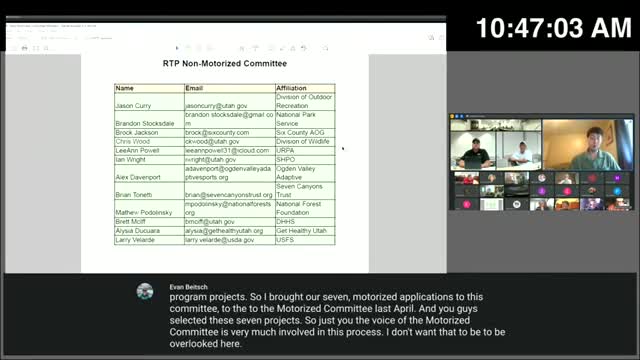Trail Funding Sparks Debate Over Motorized and Non Motorized Equity
August 23, 2024 | Utah Office of Tourism, Utah Governor's Office of Economic Opportunity, Offices, Departments, and Divisions, Organizations, Utah Executive Branch, Utah
This article was created by AI summarizing key points discussed. AI makes mistakes, so for full details and context, please refer to the video of the full meeting. Please report any errors so we can fix them. Report an error »

In a recent government meeting focused on the management of recreational trails, discussions highlighted the need for improved collaboration between motorized and non-motorized user groups. Participants emphasized the importance of including diverse perspectives from various recreational communities to ensure fair representation in decision-making processes.
One key point raised was the necessity of having representatives from both motorized and non-motorized groups on relevant committees. This suggestion aims to foster better communication and cooperation among user groups, particularly in the context of funding and trail development. The Wasatch Front, known for its dense population of outdoor enthusiasts, was cited as an area where harmonious coexistence among different user groups is essential.
The meeting also addressed the distribution of grant funds, with nearly $3 million awarded this year to support various trail projects. Of this, approximately $2.5 million was allocated to non-motorized projects, while all seven motorized applications received funding. Participants expressed optimism about the potential for future projects that could benefit both motorized and non-motorized users, thereby maximizing the impact of available resources.
Concerns were raised regarding the perception that the Off-Highway Vehicle (OHV) community feels overlooked in favor of non-motorized initiatives. Attendees acknowledged the need to address these perceptions and ensure that all user groups feel valued and included in the planning and funding processes.
The meeting concluded with a commitment to enhance user input in future grant cycles and to explore innovative funding strategies that could support projects benefiting both motorized and non-motorized recreation. Participants expressed a desire for ongoing dialogue and collaboration to improve the management of Utah's recreational trails, ensuring they meet the needs of all users while promoting sustainable outdoor activities.
One key point raised was the necessity of having representatives from both motorized and non-motorized groups on relevant committees. This suggestion aims to foster better communication and cooperation among user groups, particularly in the context of funding and trail development. The Wasatch Front, known for its dense population of outdoor enthusiasts, was cited as an area where harmonious coexistence among different user groups is essential.
The meeting also addressed the distribution of grant funds, with nearly $3 million awarded this year to support various trail projects. Of this, approximately $2.5 million was allocated to non-motorized projects, while all seven motorized applications received funding. Participants expressed optimism about the potential for future projects that could benefit both motorized and non-motorized users, thereby maximizing the impact of available resources.
Concerns were raised regarding the perception that the Off-Highway Vehicle (OHV) community feels overlooked in favor of non-motorized initiatives. Attendees acknowledged the need to address these perceptions and ensure that all user groups feel valued and included in the planning and funding processes.
The meeting concluded with a commitment to enhance user input in future grant cycles and to explore innovative funding strategies that could support projects benefiting both motorized and non-motorized recreation. Participants expressed a desire for ongoing dialogue and collaboration to improve the management of Utah's recreational trails, ensuring they meet the needs of all users while promoting sustainable outdoor activities.
View full meeting
This article is based on a recent meeting—watch the full video and explore the complete transcript for deeper insights into the discussion.
View full meeting

